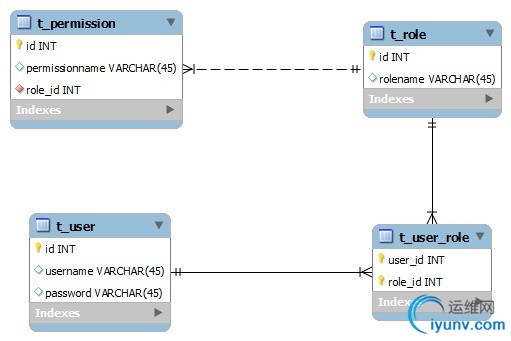|
|
在做网站开发中,用户权限必须要考虑的,权限这个东西很重要,它规定了用户在使用中能进行哪些操作,和不能进行哪些操作;我们完全可以使用过滤器来进行权限的操作,但是有了权限框架之后,使用起来会非常的方便,一般在公司里面做网站开发常用的权限框架有Spring的Security框架,和Apache的Shiro框架;Spring Security框架在使用上相比Shiro来说要更复杂一些,并且它限制了数据库该怎么去建表,只有按它的要求去建表,才能达到你想要的效果。下面我主要介绍一下Shiro框架的使用,由于本人也是初学者,所写难免会有些不合理的地方,望各位指正;
使用Apache Shiro框架的步骤:
1.导入相应的jar包,我使用的是maven来管理的,pom.xml配置如下:
<project xmlns="http://maven.apache.org/POM/4.0.0" xmlns:xsi="http://www.w3.org/2001/XMLSchema-instance"
xsi:schemaLocation="http://maven.apache.org/POM/4.0.0 http://maven.apache.org/maven-v4_0_0.xsd">
<modelVersion>4.0.0</modelVersion>
<groupId>com.kaishengit</groupId>
<artifactId>springmvctest</artifactId>
<packaging>war</packaging>
<version>0.0.1-SNAPSHOT</version>
<name>springmvctest Maven Webapp</name>
<url>http://maven.apache.org</url>
<dependencies>
<dependency>
<groupId>junit</groupId>
<artifactId>junit</artifactId>
<version>3.8.1</version>
<scope>test</scope>
</dependency>
<dependency>
<groupId>jstl</groupId>
<artifactId>jstl</artifactId>
<version>1.2</version>
</dependency>
<dependency>
<groupId>javax.servlet</groupId>
<artifactId>servlet-api</artifactId>
<version>2.5</version>
</dependency>
<dependency>
<groupId>org.springframework</groupId>
<artifactId>spring-webmvc</artifactId>
<version>3.2.4.RELEASE</version>
</dependency>
<dependency>
<groupId>org.codehaus.jackson</groupId>
<artifactId>jackson-mapper-asl</artifactId>
<version>1.9.10</version>
</dependency>
<dependency>
<groupId>commons-fileupload</groupId>
<artifactId>commons-fileupload</artifactId>
<version>1.3</version>
</dependency>
<dependency>
<groupId>org.springframework</groupId>
<artifactId>spring-jdbc</artifactId>
<version>3.2.4.RELEASE</version>
</dependency>
<dependency>
<groupId>org.springframework</groupId>
<artifactId>spring-orm</artifactId>
<version>3.2.4.RELEASE</version>
</dependency>
<!-- Hibernate -->
<dependency>
<groupId>org.hibernate</groupId>
<artifactId>hibernate-core</artifactId>
<version>4.2.5.Final</version>
</dependency>
<dependency>
<groupId>org.hibernate</groupId>
<artifactId>hibernate-ehcache</artifactId>
<version>4.2.5.Final</version>
</dependency>
<dependency>
<groupId>net.sf.ehcache</groupId>
<artifactId>ehcache</artifactId>
<version>2.7.2</version>
</dependency>
<dependency>
<groupId>commons-dbcp</groupId>
<artifactId>commons-dbcp</artifactId>
<version>1.4</version>
</dependency>
<dependency>
<groupId>mysql</groupId>
<artifactId>mysql-connector-java</artifactId>
<version>5.1.26</version>
</dependency>
<dependency>
<groupId>javax.inject</groupId>
<artifactId>javax.inject</artifactId>
<version>1</version>
</dependency>
<dependency>
<groupId>org.hibernate</groupId>
<artifactId>hibernate-validator</artifactId>
<version>5.0.1.Final</version>
</dependency>
<!--Apache Shiro所需的jar包-->
<dependency>
<groupId>org.apache.shiro</groupId>
<artifactId>shiro-core</artifactId>
<version>1.2.2</version>
</dependency>
<dependency>
<groupId>org.apache.shiro</groupId>
<artifactId>shiro-web</artifactId>
<version>1.2.2</version>
</dependency>
<dependency>
<groupId>org.apache.shiro</groupId>
<artifactId>shiro-spring</artifactId>
<version>1.2.2</version>
</dependency>
</dependencies>
<build>
<finalName>springmvctest</finalName>
<plugins>
<plugin>
<groupId>org.mortbay.jetty</groupId>
<artifactId>jetty-maven-plugin</artifactId>
<configuration>
<scanIntervalSeconds>10</scanIntervalSeconds>
<webApp>
<contextPath>/</contextPath>
</webApp>
<connectors>
<connector implementation="org.eclipse.jetty.server.nio.SelectChannelConnector">
<port>80</port>
<maxIdleTime>60000</maxIdleTime>
</connector>
</connectors>
</configuration>
</plugin>
</plugins>
</build>
</project>
2.在web.xml中进行配置:
<?xml version="1.0" encoding="UTF-8"?>
<web-app version="2.5"
xmlns="http://java.sun.com/xml/ns/javaee"
xmlns:xsi="http://www.w3.org/2001/XMLSchema-instance"
xsi:schemaLocation="http://java.sun.com/xml/ns/javaee
http://java.sun.com/xml/ns/javaee/web-app_2_5.xsd">
<display-name>Archetype Created Web Application</display-name>
<!-- OpenSessionInView -->
<filter>
<filter-name>opensessioninview</filter-name>
<filter-class>org.springframework.orm.hibernate4.support.OpenSessionInViewFilter</filter-class>
</filter>
<filter-mapping>
<filter-name>opensessioninview</filter-name>
<url-pattern>/*</url-pattern>
</filter-mapping>
<!-- SpringMVC中央控制器 -->
<servlet>
<servlet-name>mvc</servlet-name>
<servlet-class>org.springframework.web.servlet.DispatcherServlet</servlet-class>
</servlet>
<servlet-mapping>
<servlet-name>mvc</servlet-name>
<url-pattern>/</url-pattern>
</servlet-mapping>
<!-- Spring监听器 -->
<context-param>
<param-name>contextConfigLocation</param-name>
<param-value>classpath:applicationContext*.xml</param-value>
</context-param>
<listener>
<listener-class>org.springframework.web.context.ContextLoaderListener</listener-class>
</listener>
<!-- Shiro配置 -->
<filter>
<filter-name>shiroFilter</filter-name>
<filter-class>org.springframework.web.filter.DelegatingFilterProxy</filter-class>
</filter>
<filter-mapping>
<filter-name>shiroFilter</filter-name>
<url-pattern>/*</url-pattern>
</filter-mapping>
</web-app>
3.使用SpringMVC:在/WEB-INF/路径下配置springmvc-servlet.xml
<?xml version="1.0" encoding="UTF-8"?>
<beans xmlns="http://www.springframework.org/schema/beans"
xmlns:xsi="http://www.w3.org/2001/XMLSchema-instance"
xmlns:context="http://www.springframework.org/schema/context"
xmlns:mvc="http://www.springframework.org/schema/mvc"
xsi:schemaLocation="
http://www.springframework.org/schema/beans
http://www.springframework.org/schema/beans/spring-beans.xsd
http://www.springframework.org/schema/context
http://www.springframework.org/schema/context/spring-context.xsd
http://www.springframework.org/schema/mvc
http://www.springframework.org/schema/mvc/spring-mvc-3.0.xsd">
<!-- 自动扫描 -->
<context:component-scan base-package="com.kaishengit.controller">
<context:include-filter type="annotation" expression="org.springframework.stereotype.Controller"/>
</context:component-scan>
<mvc:annotation-driven/>
<!-- 静态资源访问 -->
<mvc:resources location="/static/" mapping="/static/**"/>
<!-- 视图解析器 -->
<bean id="viewResolver" class="org.springframework.web.servlet.view.UrlBasedViewResolver">
<property name="viewClass" value="org.springframework.web.servlet.view.JstlView"/>
<property name="prefix" value="/WEB-INF/views/"/>
<property name="suffix" value=".jsp"/>
</bean>
<!-- 文件上传解析器 -->
<bean id="multipartResolver" class="org.springframework.web.multipart.commons.CommonsMultipartResolver">
<!-- 配置最大上传文件的大小 -->
<property name="maxUploadSize" value="1000000"/>
</bean>
<!-- 拦截器 -->
<mvc:interceptors>
<mvc:interceptor>
<mvc:mapping path="/**"/>
<bean class="com.kaishengit.controller.MyInterceptor">
<property name="excluedUrls">
<list>
<value>/home</value>
</list>
</property>
</bean>
</mvc:interceptor>
</mvc:interceptors>
<!-- 异常 -->
<bean id="handlerExceptionResolver" class="org.springframework.web.servlet.handler.SimpleMappingExceptionResolver">
<property name="exceptionMappings">
<props>
<prop key="com.kaishengit.exception.AuthorizationException">redirect:/home</prop>
</props>
</property>
</bean>
</beans>
4.配置applicationContext.xml
<?xml version="1.0" encoding="UTF-8"?>
<beans xmlns="http://www.springframework.org/schema/beans"
xmlns:xsi="http://www.w3.org/2001/XMLSchema-instance"
xmlns:aop="http://www.springframework.org/schema/aop"
xmlns:tx="http://www.springframework.org/schema/tx"
xmlns:context="http://www.springframework.org/schema/context"
xsi:schemaLocation="
http://www.springframework.org/schema/beans http://www.springframework.org/schema/beans/spring-beans.xsd
http://www.springframework.org/schema/tx http://www.springframework.org/schema/tx/spring-tx.xsd
http://www.springframework.org/schema/aop http://www.springframework.org/schema/aop/spring-aop.xsd
http://www.springframework.org/schema/context http://www.springframework.org/schema/context/spring-context.xsd">
<!-- 自动扫描所有的注解,排除掉controller不扫描 -->
<context:component-scan base-package="com.kaishengit">
<context:exclude-filter type="annotation" expression="org.springframework.stereotype.Controller"/>
</context:component-scan>
<!-- 加载ClassPath中的properties文件 -->
<context:property-placeholder location="classpath:jdbc.properties"/>
<!-- 基于Hibernate的事务管理器 -->
<bean id="transactionManager" class="org.springframework.orm.hibernate4.HibernateTransactionManager">
<property name="sessionFactory" ref="sessionFactory"></property>
</bean>
<!-- 配置数据源 -->
<bean id="dataSource" class="org.apache.commons.dbcp.BasicDataSource" destroy-method="close">
<property name="driverClassName" value="${jdbc.driver}"/>
<property name="url" value="${jdbc.url}"/>
<property name="username" value="${jdbc.username}"/>
<property name="password" value="${jdbc.password}"/>
</bean>
<!-- 基于注解 -->
<tx:annotation-driven transaction-manager="transactionManager"/>
<!-- SessionFactory -->
<bean id="sessionFactory" class="org.springframework.orm.hibernate4.LocalSessionFactoryBean">
<property name="dataSource" ref="dataSource"/>
<!-- 实体类pojo所在的包 -->
<property name="packagesToScan" value="com.kaishengit.pojo"/>
<property name="hibernateProperties">
<props>
<prop key="hibernate.dialect">org.hibernate.dialect.MySQLDialect</prop>
<prop key="hibernate.show_sql">true</prop>
<prop key="hibernate.cache.region.factory_class">org.hibernate.cache.ehcache.EhCacheRegionFactory</prop>
</props>
</property>
</bean>
</beans>
5.将配置在applicationContext.xml中的shiro独立出来,新建applicationContext-shiro.xml
<?xml version="1.0" encoding="UTF-8"?>
<beans xmlns="http://www.springframework.org/schema/beans"
xmlns:xsi="http://www.w3.org/2001/XMLSchema-instance"
xmlns:context="http://www.springframework.org/schema/context"
xsi:schemaLocation="
http://www.springframework.org/schema/beans http://www.springframework.org/schema/beans/spring-beans.xsd
http://www.springframework.org/schema/context http://www.springframework.org/schema/context/spring-context.xsd">
<bean id="securityManager" class="org.apache.shiro.web.mgt.DefaultWebSecurityManager">
<property name="realm" ref="myShiro"/>
<property name="cacheManager" ref="cacheManager"/>
</bean>
<bean id="shiroFilter" class="org.apache.shiro.spring.web.ShiroFilterFactoryBean">
<property name="securityManager" ref="securityManager"/>
<property name="loginUrl" value="/login"/>
<property name="successUrl" value="/user"/>
<property name="unauthorizedUrl" value="/403"/>
<property name="filterChainDefinitions">
<value>
<!--静态资源直接通过-->
/static/** =anon
<!--只有admin角色才能访问/user/save-->
/user/save =roles[admin]
<!--具有user:add权限的用户可以访问/user/save-->
<!--/user/save =perms[user:add]-->
<!--所有的请求都要通过验证-->
/** = authc
</value>
</property>
</bean>
<bean id="cacheManager"
class="org.apache.shiro.cache.MemoryConstrainedCacheManager" />
<bean id="lifecycleBeanPostProcessor"
class="org.apache.shiro.spring.LifecycleBeanPostProcessor" />
</beans>
6.实现MyRealm:继承AuthorizingRealm,并重写认证授权方法
package com.kaishengit.service;
import java.util.List;
import javax.inject.Inject;
import org.apache.shiro.authc.AuthenticationException;
import org.apache.shiro.authc.AuthenticationInfo;
import org.apache.shiro.authc.AuthenticationToken;
import org.apache.shiro.authc.SimpleAuthenticationInfo;
import org.apache.shiro.authc.UsernamePasswordToken;
import org.apache.shiro.authz.AuthorizationInfo;
import org.apache.shiro.authz.SimpleAuthorizationInfo;
import org.apache.shiro.realm.AuthorizingRealm;
import org.apache.shiro.subject.PrincipalCollection;
import org.springframework.stereotype.Service;
import org.springframework.transaction.annotation.Transactional;
import com.kaishengit.pojo.Role;
import com.kaishengit.pojo.User;
@Service
@Transactional
public class MyRealm extends AuthorizingRealm{
@Inject
private UserService userService;
/**
* 权限认证
*/
@Override
protected AuthorizationInfo doGetAuthorizationInfo(PrincipalCollection principalCollection) {
//获取登录的用户名
String loginName=(String) principalCollection.fromRealm(getName()).iterator().next();
User user=userService.findByName(loginName);
if(user!=null){
SimpleAuthorizationInfo info=new SimpleAuthorizationInfo();
//登录的用户有多少个角色
info.setRoles(user.getRolesName());
List<Role> roleList=user.getRoleList();
for(Role role:roleList){
//角色有多少个权限
info.addStringPermissions(role.getPermissionNames());
}
return info;
}
return null;
}
/**
* 登录认证
*/
@Override
protected AuthenticationInfo doGetAuthenticationInfo(
AuthenticationToken authenticationToken) throws AuthenticationException {
UsernamePasswordToken token = (UsernamePasswordToken) authenticationToken;
User user = userService.findByName(token.getUsername());
if(user != null) {
return new SimpleAuthenticationInfo(user.getUsername(), user.getPassword(), getName());
}
return null;
}
}
7.HomeController.java
package com.kaishengit.controller;
import org.apache.shiro.SecurityUtils;
import org.apache.shiro.authc.AuthenticationException;
import org.apache.shiro.authc.UsernamePasswordToken;
import org.springframework.stereotype.Controller;
import org.springframework.web.bind.annotation.RequestMapping;
import org.springframework.web.bind.annotation.RequestMethod;
import org.springframework.web.servlet.mvc.support.RedirectAttributes;
import com.kaishengit.pojo.User;
@Controller
public class HomeController {
@RequestMapping(value="/login",method=RequestMethod.GET)
public String loginForm(){
return "/login";
}
@RequestMapping(value="/login",method=RequestMethod.POST)
public String login(User user,RedirectAttributes redirectAttributes){
try {
SecurityUtils.getSubject().login(new UsernamePasswordToken(user.getUsername(), user.getPassword()));
return "redirect:/user";
} catch (AuthenticationException e) {
redirectAttributes.addFlashAttribute("message", "用户名或密码错误");
return "redirect:/login";
}
}
@RequestMapping(value="/logout",method=RequestMethod.GET)
public String logout(RedirectAttributes redirectAttributes ){
SecurityUtils.getSubject().logout();
redirectAttributes.addFlashAttribute("message", "您已安全退出");
return "redirect:/login";
}
}
8.在jsp中使用Shiro标签库:
<%@ taglib prefix="shiro" uri="http://shiro.apache.org/tags" %>
<html>
<head>
<title>page</title>
</head>
<body>
<!--显示登录的用户名-->
<h2>welcome!<shiro:principal/></h2>
<a href="/logout">安全退出</a>
<!--角色为manager的用户登录后会显示添加按钮,否则不显示-->
<shiro:hasRole name="manager">
<a href="/user/save">添加</a>
</shiro:hasRole>
</body>
</html>
9.数据库中建表,E-R图如下:

|
|
|